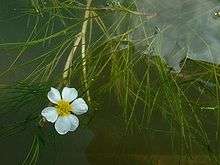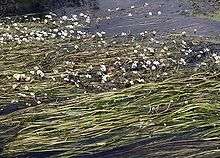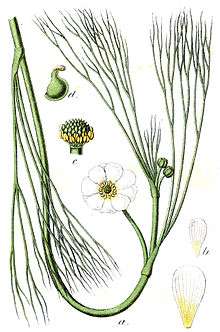Ranunculus fluitans
| Ranunculus fluitans | |
|---|---|
 | |
| Scientific classification | |
| Kingdom: | Plantae |
| Clade: | Angiosperms |
| Clade: | Eudicots |
| Order: | Ranunculales |
| Family: | Ranunculaceae |
| Genus: | Ranunculus |
| Species: | R. fluitans |
| Binomial name | |
| Ranunculus fluitans | |
| Synonyms | |
| |
Ranunculus fluitans (the river water-crowfoot,[2]) is a species of buttercup. It is a perennial water plant, that when in favourable conditions (such as fast flowing water,[3]) it can grow up to 6 m (20 ft) height.[4]
Description
Ranunculus fluitans has no floating leaves, instead it has long and narrow, tassel-like segments. Reaching up to 30 cm (12 in) long. The long slender stems can have up to two flower stems. The white flowers are held above the water level, they are around 2–3 cm across. They are daisy-like, with 6-8 overlapping petals around a central yellow area. It blooms in June, then the rounded seed heads become hairless fruits.[3] It is similar in form to Ranunculus trichophyllus (thread-leaved water-crowfoot), apart from flower petal number, thread-leaved has on 5 petals and shorter leaves, as thread-leaved prefers slower flowing waters.[3]
Taxonomy
It was formerly described by the French naturalist and botanist Jean-Baptiste Lamarck in his book 'Flore françoise' Vol.3 on page 184 in 1779.[1][5]
Distribution
It is endemic to western Europe.[7]
Range
It can be found in Ireland, the United Kingdom, southern Sweden, France, Germany, Poland, Switzerland, Austria, the Czech Republic, Slovenia, Slovakia, Hungary and Italy.[7] It grows in fast flowing waters of the UK, within England, Scotland and Wales.[3]
Ecology

A Ranunculus fluitans community or Ranunculion fluitantis, defines a British plant community comprising stands of submerged vegetation dominated by clumps of Crowfoot.[4] It is thought to be Vulnerable in Sweden and Near Threatened in Switzerland, but elsewhere it is widespread and abundant.[7]
Culture

William Barnes (1801–1886) an English writer, poet and Church of England priest, referred to the plant in his poem 'The Water Crowfoot'.
O small feac'd flow'r that now dost bloom
To stud wi'white the shallow Frome,
An' leave the clote to spread his flow'r
On darksome pools o' stwoneless Stour.[8]
This refers to the River Frome's being at danger from man's interference.[3]
References
- 1 2 "Ranunculus fluitans Lam. is an accepted name". 23 March 2012. theplantlist.org. Retrieved 26 October 2017.
- ↑ "BSBI List 2007". Botanical Society of Britain and Ireland. Archived from the original (xls) on 2015-01-25. Retrieved 2014-10-17.
- 1 2 3 4 5 Reader's Digest Field Guide to the Wild Flowers of Britain. Reader's Digest. 1981. p. 30. ISBN 9780276002175.
- 1 2 J. S. Rodwell; British Plant Communities: Woodlands and Scrub Cambridge University Press, 1990 ISBN 0-521-62718-4
- ↑ "Ranunculaceae Ranunculus fluitans Lam". ipni.org. Retrieved 26 October 2017.
- ↑ Archibald William Smith A Gardener's Handbook of Plant Names: Their Meanings and Origins, p. 140, at Google Books
- 1 2 3 Lansdown,, R.V. (2013). "Ranunculus fluitans". iucnredlist.org (IUCN). Retrieved 27 October 2017.
- ↑ S. Gatrell Thomas Hardy’s Vision of Wessex, p. 68, at Google Books
External links
| Wikimedia Commons has media related to Ranunculus fluitans. |
| Wikispecies has information related to Ranunculus fluitans |
